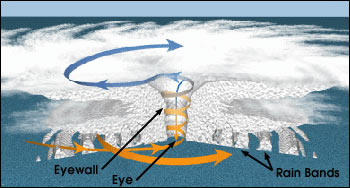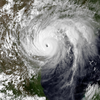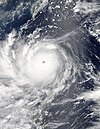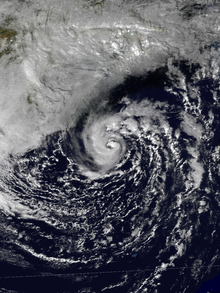
Back بوابة:الأعاصير المدارية Arabic Portal:Ciclons tropicals Catalan Portal:Ciclones tropicales Spanish 포털:태풍 Korean Portaal:Tropische cyclonen Dutch Portal:Ciclones tropicais Portuguese สถานีย่อย:พายุหมุนเขตร้อน Thai Portal:熱帶氣旋 Chinese
The Tropical Cyclones Portal

A tropical cyclone is a storm system characterized by a large low-pressure center, a closed low-level circulation and a spiral arrangement of numerous thunderstorms that produce strong winds and heavy rainfall. Tropical cyclones feed on the heat released when moist air rises, resulting in condensation of water vapor contained in the moist air. They are fueled by a different heat mechanism than other cyclonic windstorms such as Nor'easters, European windstorms and polar lows, leading to their classification as "warm core" storm systems. Most tropical cyclones originate in the doldrums, approximately ten degrees from the Equator.
The term "tropical" refers to both the geographic origin of these systems, which form almost exclusively in tropical regions of the globe, as well as to their formation in maritime tropical air masses. The term "cyclone" refers to such storms' cyclonic nature, with anticlockwise rotation in the Northern Hemisphere and clockwise rotation in the Southern Hemisphere. Depending on its location and intensity, a tropical cyclone may be referred to by names such as "hurricane", "typhoon", "tropical storm", "cyclonic storm", "tropical depression" or simply "cyclone".
Types of cyclone: 1. A "Typhoon" is a tropical cyclone located in the North-west Pacific Ocean which has the most cyclonic activity and storms occur year-round. 2. A "Hurricane" is also a tropical cyclone located at the North Atlantic Ocean or North-east Pacific Ocean which have an average storm activity and storms typically form between May 15 and November 30. 3. A "Cyclone" is a tropical cyclone that occurs in the South Pacific and Indian Oceans.
Selected named cyclone -
The 1991 Perfect Storm, also known as The No-Name Storm (especially in the years immediately after it took place) and the Halloween Gale/Storm, was a damaging and deadly nor'easter in October 1991. Initially an extratropical cyclone, the storm absorbed Hurricane Grace to its south and evolved into a small unnamed hurricane later in its life. Damage from the storm totaled over $200 million (1991 USD) and thirteen people were killed in total, six of which were an outcome of the sinking of Andrea Gail, which inspired the book and later movie, The Perfect Storm. The nor'easter received the name, playing off the common expression, after a conversation between Boston National Weather Service forecaster Robert Case and author Sebastian Junger.
The initial area of low pressure developed off the coast of Atlantic Canada on October 28. Forced southward by a ridge to its north, it reached its peak intensity as a large and powerful cyclone. The storm lashed the east coast of the United States with high waves and coastal flooding before turning to the southwest and weakening. Moving over warmer waters, the system transitioned into a subtropical cyclone before becoming a tropical storm. It executed a loop off the Mid-Atlantic states and turned toward the northeast. On November 1, the system evolved into a full-fledged hurricane, with peak sustained winds of 75 miles per hour (120 km/h), although the National Hurricane Center left it unnamed to avoid confusion amid media interest in the precursor extratropical storm. The system was the twelfth and final tropical cyclone, the eighth tropical storm, and fourth hurricane in the 1991 Atlantic hurricane season. The tropical system weakened, striking Nova Scotia as a tropical storm before dissipating. (Full article...)Selected article -
The 1933 Treasure Coast hurricane was the second-most intense tropical cyclone to strike the United States during the active 1933 Atlantic hurricane season. The eleventh tropical storm, fifth hurricane, and the third major hurricane of the season, it formed east-northeast of the Leeward Islands on August 31. The tropical storm moved rapidly west-northwestward, steadily intensifying to a hurricane. It acquired peak winds of 140 mph (220 km/h) and passed over portions of the Bahamas on September 3, including Eleuthera and Harbour Island, causing severe damage to crops, buildings, and infrastructure. Winds over 100 mph (160 km/h) affected many islands in its path, especially those that encountered its center, and many wharves were ruined.
Subsequently, it weakened and made landfall at Jupiter, Florida, early on September 4 with winds of 125 mph (205 km/h). The hurricane moved across the state, passing near Tampa before moving into Georgia and dissipating. In Florida, the strong winds of the cyclone blew buildings off their foundations, and numerous trees were prostrated in citrus groves. The Treasure Coast region received the most extensive destruction, and Stuart, Jupiter, and Fort Pierce were heavily damaged. The storm was locally regarded as the most severe on record in 50 years. Inland, the cyclone weakened rapidly but produced prodigious amounts of rain, causing a dam to collapse near Tampa. The storm caused $3 million in damage (1933 USD) after damaging or destroying 6,848 homes. (Full article...)Selected image -

Selected season -

The 2017 Pacific hurricane season was an above average Pacific hurricane season in terms of named storms, though less active than the previous three, featuring eighteen named storms, nine hurricanes, and four major hurricanes. Despite the considerable amount of activity, most of the storms were weak and short-lived. The season officially started on May 15 in the eastern Pacific Ocean, and on June 1 in the central Pacific; they both ended on November 30. These dates conventionally delimit the period of each year when most tropical cyclones form in the respective regions. However, the formation of tropical cyclones is possible at any time of the year, as illustrated in 2017 by the formation of the season's first named storm, Tropical Storm Adrian, on May 9. At the time, this was the earliest formation of a tropical storm on record in the eastern Pacific basin proper (east of 140°W). The season saw near-average activity in terms of accumulated cyclone energy (ACE), in stark contrast to the extremely active seasons in 2014, 2015, and 2016; and for the first time since 2012, no tropical cyclones formed in the Central Pacific basin. However, for the third year in a row, the season featured above-average activity in July, with the ACE value being the fifth highest for the month. Damage across the basin reached $375.28 million (2017 USD), while 45 people were killed by the various storms.
Prior to the start of this season, the National Hurricane Center (NHC) changed its policy to permit issuance of advisories on disturbances that were not yet tropical cyclones but had a high chance to become one, and were expected to bring tropical storm or hurricane conditions to landmasses within 48 hours. As a result of this change, watches and warnings could be issued by local authorities. Such systems would be termed as "Potential Tropical Cyclones". The first system to receive this designation was Potential Tropical Cyclone Fourteen-E, which developed into Tropical Storm Lidia south-southeast of the Baja California Peninsula on August 30.
(Full article...)Related portals
Currently active tropical cyclones

Italicized basins are unofficial.
- North Atlantic (2024)
- No active systems
- North Indian Ocean (2024)
- No active systems
- Mediterranean (2024–25)
- No active systems
- South-West Indian Ocean (2024–25)
- No active systems
- Australian region (2024–25)
- No active systems
- South Pacific (2024–25)
- No active systems
- South Atlantic (2024–25)
- No active systems
Last updated: 11:13, 25 August 2024 (UTC)
Tropical cyclone anniversaries

August 24,
- 1992 - Hurricane Andrew (pictured) made landfall near Homestead, Florida as a Category 5 hurricane. Andrew caused about $26 billion in total damages.
- 2015 - Typhoon Goni reaches its maximum intensity over in the Ryukyu Islands. In total, Goni killed 74 people and damages topped to $830 million.

August 25
- 1873 - The 1873 Nova Scotia hurricane moved away from the Nova Scotia coast towards Newfoundland, after killing about 500 people and causing $5.9 million of damage.
- 2017 - Hurricane Harvey (pictured) reached its peak strength as a Category 4 hurricane, shortly before making landfall over Texas, which killed 106 people in the US and caused around $125 billion (2017 USD) in damages, making Harvey the second-costliest tropical cyclone worldwide.

August 26
- 1931 - After a typhoon moved ashore China near Ningbo, heavy rainfall caused portions of the Grand Canal to collapse, leaving to a wall of water that killed 300,000 people during the country's worst floods on record.
- 2004 - Typhoon Aere made landfall near Xiamen as a weakening Category 1 typhoon. Overall, Aere killed a total of 107 people.
- 2011 - Typhoon Nanmadol (pictured) reached Category 5 super typhoon intensity as it made landfall over Gonzaga, Cagayan. In the Philippines, 38 people were killed by the storm, including $34.5 million in damages.
Did you know…




- …that the Joint Typhoon Warning Center considers that Typhoon Vera (pictured) of 1986 is actually two distinct systems, formed from two separated low-level circulations?
- …that Cyclone Freddy (track pictured) in 2023 was the longest-lasting tropical cyclone worldwide?
- …that Cyclone Raquel (track pictured) travelled between the Australian and South Pacific basins between the 2014–15 and 2015–16 seasons, spanning both seasons in both basins?
- …that Hurricane Otis (pictured) in 2023 was the first Pacific hurricane to make landfall at Category 5 intensity and surpassed Hurricane Patricia as the strongest landfalling Pacific hurricane on record?
General images -

Category 3 is the third-highest classification on the Saffir–Simpson hurricane wind scale, and categorizes tropical cyclones with 1-minute maximum sustained winds between 96 and 112 knots (110 and 129 mph; 178 and 207 km/h; 49 and 58 m/s). Tropical cyclones that attain such winds and move over land while maintaining those winds are capable of causing severe damage to human lives and infrastructure. From 1949 to 2023, a total of 85 recorded Pacific hurricanes have peaked at Category 3 strength within the Northeast Pacific tropical cyclone basin, which is denoted as the part of the Pacific Ocean north of the equator and east of the International Date Line. This does not include storms that also attained Category 4 or 5 status on the scale.
The development of Category 3 hurricanes in the Northeast Pacific basin is influenced by many factors. During the Northern Hemisphere winter and spring months of December to April, sea surface temperatures in the tropics are usually too low to support tropical cyclogenesis. Furthermore, from January to April, the North Pacific High and Aleutian Low induce strong vertical wind shear and unfavorable conditions that serve to prevent the development of hurricanes. These effects are reduced or even disappear during hurricane season from May to November, when sea surface temperatures are also high enough to support tropical cyclogenesis; the bulk of recorded Category 3 hurricanes developed during June to October. Global weather patterns may also influence hurricane development in the Northeast Pacific. El Niño events result in increased numbers of powerful hurricanes through weaker wind shear and higher sea surface temperatures within the basin, while La Niña events reduce the number of such hurricanes through the opposite. (Full article...)Topics
Subcategories
Related WikiProjects
WikiProject Tropical cyclones is the central point of coordination for Wikipedia's coverage of tropical cyclones. Feel free to help!
WikiProject Weather is the main center point of coordination for Wikipedia's coverage of meteorology in general, and the parent project of WikiProject Tropical cyclones. Three other branches of WikiProject Weather in particular share significant overlaps with WikiProject Tropical cyclones:
- The Non-tropical storms task force coordinates most of Wikipedia's coverage on extratropical cyclones, which tropical cyclones often transition into near the end of their lifespan.
- The Floods task force takes on the scope of flooding events all over the world, with rainfall from tropical cyclones a significant factor in many of them.
- WikiProject Severe weather documents the effects of extreme weather such as tornadoes, which landfalling tropical cyclones can produce.
Things you can do
 |
Here are some tasks awaiting attention:
|
Wikimedia
The following Wikimedia Foundation sister projects provide more on this subject:
-
Commons
Free media repository -
Wikibooks
Free textbooks and manuals -
Wikidata
Free knowledge base -
Wikinews
Free-content news -
Wikiquote
Collection of quotations -
Wikisource
Free-content library -
Wikiversity
Free learning tools -
Wikivoyage
Free travel guide -
Wiktionary
Dictionary and thesaurus
© MMXXIII Rich X Search. We shall prevail. All rights reserved. Rich X Search
























































